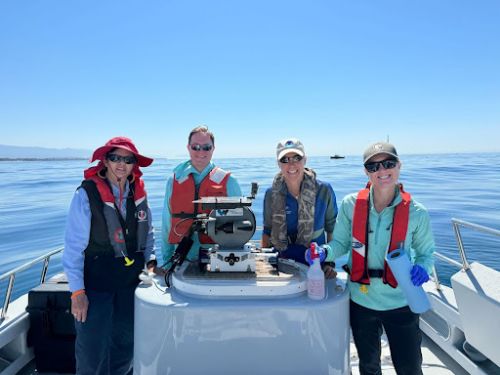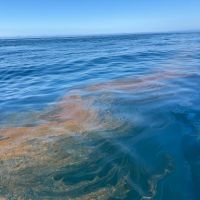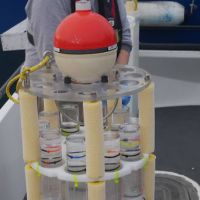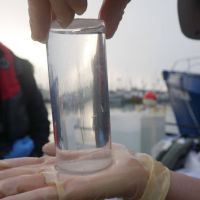OR&R and Partners Test Oil Spill Technologies Off the Coast of Santa Barbara to Advance Emergency Spill Response
AUGUST 12, 2024 — A team of OR&R scientists, data managers, and support staff gathered in Santa Barbara, California in collaboration with the Coastal Response Research Center (CRRC) at the University of New Hampshire, the U.S. Coast Guard (USCG), and private industry partners to advance technological capabilities for detecting and characterizing spilled oil and the impacts to aquatic wildlife. Known as the “Science on Disasters of Opportunity” project, the research aims to prepare OR&R and partners to better respond to and assess the impacts from an actual hazardous spill in the environment.
Over the three-day project conducted in late July, the research team deployed MetOcean Stokes Drifters, a remotely operated vehicle (ROV), the Drifting Exposure and Effects Assessment Ring (DEEAR), equipment for traditional oil sampling, and uncrewed aircraft systems (UAS), commonly known as “drones,” in and over the natural oil seeps off the coast of Santa Barbara. The project goals were to help OR&R validate and operationalize tools and methods that enhance spill detection, tracking, and oil effects monitoring. To support this on-the-water testing, the CRRC coordinated the research and hired two fishing charters, the Fin Addict and Loose Cannon, to help complete the fieldwork. The USCG Cutter Blackfin also went underway with observers and Coast Guard UAS pilots to test their aerial overflight capabilities and support overall field testing missions.
The primary research team, led by OR&R and the CRRC, split into two teams to simultaneously begin testing aboard each fishing charter. Team one deployed the MetOcean drifters—buoys designed to float and drift with surface oil slicks— and the Deep Trekker Remotely Operated Vehicle for Environmental Response (ROVER). The drifters, tracked remotely with GPS, can transmit data even with oil coating their surface. During an actual incident, NOAA modelers can track the drifters’ movement as it drifts with a spill and use this information to provide updated fate and trajectory models. Additionally, the ROVER was deployed underneath oil slicks to collect water samples and imagery to characterize the oil in the water.
Team two deployed the DEEAR under surface oil slicks and in unoiled control areas for comparison, and focused on UAS mapping capabilities. The DEEAR is an in situ bioassay system designed to move with water currents and assess the toxicity of oil spills to aquatic organisms. The DEEAR unit has a ring of exposure chambers suspended inside which are loaded with early-stage fish or shrimp. Surrounding water is pumped through the device’s chambers as the system drifts with oil, mimicking how planktonic organisms move in the water and are exposed to oil beneath slicks. The unit also contains an array of water quality sensors, a fluorometer, and polyethylene passive sampling devices to characterize oil exposure. The DEEAR was retrieved the next day, organisms were counted, and live fish and shrimp were transferred to clean seawater for longer term evaluations of oil exposure and toxic effects. Data from the DEEAR help scientists understand how different concentrations of oil in water impacts aquatic invertebrates and fish. The team simultaneously flew an aerial drone to provide tracking and mapping of surface oil to help uncover what is happening beneath different types of oil slicks. The continued advancements of the DEEAR can help scientists to track biological and chemical data in real time during an oil spill.
Back on shore, OR&R’s data management team and CRRC remote staff monitored deployed sensors and other technologies to ensure data was being collected, tracked, and displayed in-sync across platforms, including the Environmental Response Management Application (ERMA®) .
This on-the-water research will help OR&R and its partners advance how information from multiple platforms is received, interpreted, and shared with spill responders and communities. Preparing new tools, technologies, and methods to be utilized during a future real-time oil spill event is essential to improving overall spill response and recovery efforts. Stay tuned for a future OR&R blog to learn about the results of this project.
more images



 An official website of the United States government.
An official website of the United States government.




